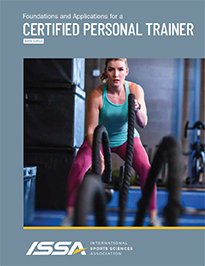Certified Personal Trainer Special Discount Enroll Now
Certified Personal Trainer Special Discount Enroll Now
Table of Contents
Chapter 1: HEALTH, FITNESS, AND PERSONAL TRAINING
The History of Personal Training
The Future of Personal Training and Fitness
ISSA Certified Personal Trainer Code of Ethics
Chapter 2: PSYCHOLOGY OF BEHAVIOR CHANGE
Behavior Change
Stages of Change
Processes of Change
Motivational Theories and Applications
Motivational Interviewing
Blending SDT and MI
Setting Goals That Motivate Behavior
Scope of Practice
Chapter 3: MOVEMENT SYSTEMS
The Nervous System
The Muscular System
The Skeletal System
Joints in the Human Body
Chapter 4: SUPPORTING SYSTEMS
The Circulatory System
The Lymphatic System
The Respiratory System
The Endocrine System
The Digestive System
The Integumentary System
Chapter 5: CONCEPTS OF BIOMECHANICS
Anatomical Reference Terms
Balance, Equilibrium, and Stability
The Laws of Motion
Friction
Levers
Torque
Muscles as Movers
Chapter 6: ENERGY AND METABOLISM
Cells
Food as Energy
Adenosine Triphosphate (ATP)
Anaerobic Energy Production
Aerobic Energy Production
Metabolism and Energy Balance
Chapter 7: CLIENT ASSESSMENTS
Subjective Assessments
Objective Assessments
Body Composition Assessments
Cardiorespiratory Fitness Assessments
VO2 Max Norms
Muscular Strength and Muscular Endurance Assessments
Movement and Posture Assessments
Posture and Movement Assessments
Interpreting Findings
Chapter 8: ELEMENTS OF FITNESS
The Warm-up
Flexibility Training
Core Training
Balance Training
Reactive Training
Resistance Training
Cardiorespiratory Training
The Cooldown
Chapter 9: PRINCIPLES OF PROGRAM DESIGN
Acute Variables of Fitness
The Principles of Fitness
Periodization
Overreaching and Overtraining
Training Categories and the Elements of a Fitness Program
Chapter 10: CONCEPTS OF FLEXIBILITY TRAINING
Methods of Flexibility Training
Flexibility and the Principle of Specificity
Acute Variables for Flexibility
Dynamic Stretching
Pre-Contraction Stretching
Static Stretching
Flexibility and Special Populations
Self-Myofascial Release
Chapter 11: CONCEPTS OF CARDIOVASCULAR EXERCISE
Benefits of Cardiovascular Exercise
Cardiovascular Training Principles
Modifying Acute Training Variables
Measures of Cardiorespiratory Fitness
Warm-Up and Cooldown
Physiological Adaptations to Aerobic Exercise
Modes of Cardiovascular Exercise
Environmental Influences on Activity
Chapter 12: CONCEPTS OF RESISTANCE TRAINING
Benefits of Strength Training
Classifying Strength
Strength Curve
Strength Training and Training Principles
Physiological Adaptations to Anaerobic Exercise
Modifying the Acute Training Variables
Resistance Equipment
Comparing Free Weights and Weight Machines
Body Weight Exercise
Rep and Set Schemes
Sample Strength Training Workouts
Chapter 13: EXERCISE SELECTION AND TECHNIQUE
Common Exercise Injuries and Injury Prevention
Key Communication Principles
Cueing
Movement Categories
Exercise Categories
Chapter 14: NUTRITION FOUNDATIONS
Macronutrients
Water
Micronutrients
Dietary Guidelines and MyPlate
Understanding Food Labels
Common Diet Trends
Portion Sizes
Chapter 15: SUPPLEMENTATION
What Is a Dietary Supplement?
Nutritional Supplements
Performance Supplements
Ergogenic Aids
Botanical Supplements
Chapter 16: CHRONIC CONDITIONS
Exercise and Hypertension
Exercise and Diabetes
Exercise and Arthritis
Exercise and Coronary Heart Disease
Exercise and Asthma
Chapter 17: LIFESPAN POPULATIONS
Exercise and Youth
Exercise and Older Adults
Exercise and Pregnancy
Exercise and Adaptive Fitness
Chapter 18: BUSINESS AND MARKETING
Styles of Personal Training
Starting a Personal Training Business
Marketing a Business
The Client Life Cycle
The Importance of Client Retention
Managing a Personal Training Business
Personal Training Best Practices (Advice from Seasoned Fitness Professionals & Code of Ethics)
Chapter 19: SAFETY AND EMERGENCY SITUATIONS
Own the Fitness Floor
CPR Certification
Injury Prevention
Emergency Equipment and Protocols
When to Call Emergency Services

